Page 79 of 430
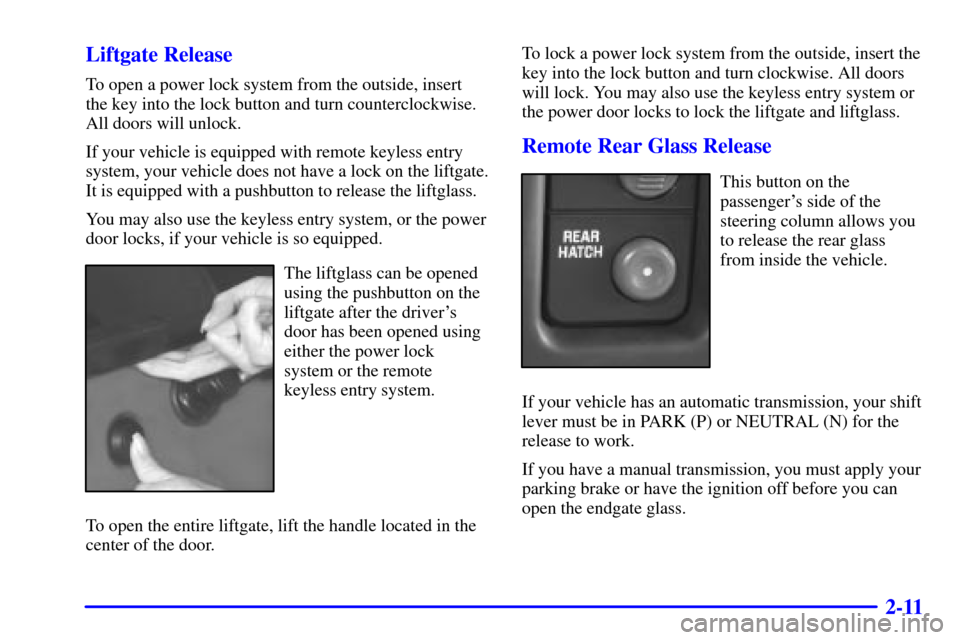
2-11 Liftgate Release
To open a power lock system from the outside, insert
the key into the lock button and turn counterclockwise.
All doors will unlock.
If your vehicle is equipped with remote keyless entry
system, your vehicle does not have a lock on the liftgate.
It is equipped with a pushbutton to release the liftglass.
You may also use the keyless entry system, or the power
door locks, if your vehicle is so equipped.
The liftglass can be opened
using the pushbutton on the
liftgate after the driver's
door has been opened using
either the power lock
system or the remote
keyless entry system.
To open the entire liftgate, lift the handle located in the
center of the door.To lock a power lock system from the outside, insert the
key into the lock button and turn clockwise. All doors
will lock. You may also use the keyless entry system or
the power door locks to lock the liftgate and liftglass.
Remote Rear Glass Release
This button on the
passenger's side of the
steering column allows you
to release the rear glass
from inside the vehicle.
If your vehicle has an automatic transmission, your shift
lever must be in PARK (P) or NEUTRAL (N) for the
release to work.
If you have a manual transmission, you must apply your
parking brake or have the ignition off before you can
open the endgate glass.
Page 89 of 430
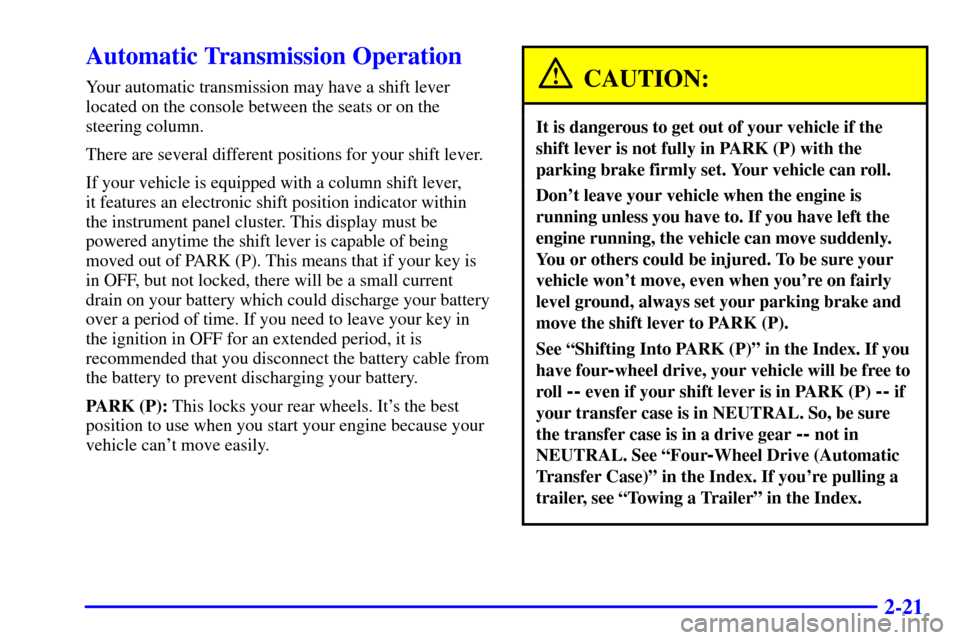
2-21
Automatic Transmission Operation
Your automatic transmission may have a shift lever
located on the console between the seats or on the
steering column.
There are several different positions for your shift lever.
If your vehicle is equipped with a column shift lever,
it features an electronic shift position indicator within
the instrument panel cluster. This display must be
powered anytime the shift lever is capable of being
moved out of PARK (P). This means that if your key is
in OFF, but not locked, there will be a small current
drain on your battery which could discharge your battery
over a period of time. If you need to leave your key in
the ignition in OFF for an extended period, it is
recommended that you disconnect the battery cable from
the battery to prevent discharging your battery.
PARK (P): This locks your rear wheels. It's the best
position to use when you start your engine because your
vehicle can't move easily.CAUTION:
It is dangerous to get out of your vehicle if the
shift lever is not fully in PARK (P) with the
parking brake firmly set. Your vehicle can roll.
Don't leave your vehicle when the engine is
running unless you have to. If you have left the
engine running, the vehicle can move suddenly.
You or others could be injured. To be sure your
vehicle won't move, even when you're on fairly
level ground, always set your parking brake and
move the shift lever to PARK (P).
See ªShifting Into PARK (P)º in the Index. If you
have four
-wheel drive, your vehicle will be free to
roll
-- even if your shift lever is in PARK (P) -- if
your transfer case is in NEUTRAL. So, be sure
the transfer case is in a drive gear
-- not in
NEUTRAL. See ªFour
-Wheel Drive (Automatic
Transfer Case)º in the Index. If you're pulling a
trailer, see ªTowing a Trailerº in the Index.
Page 95 of 430
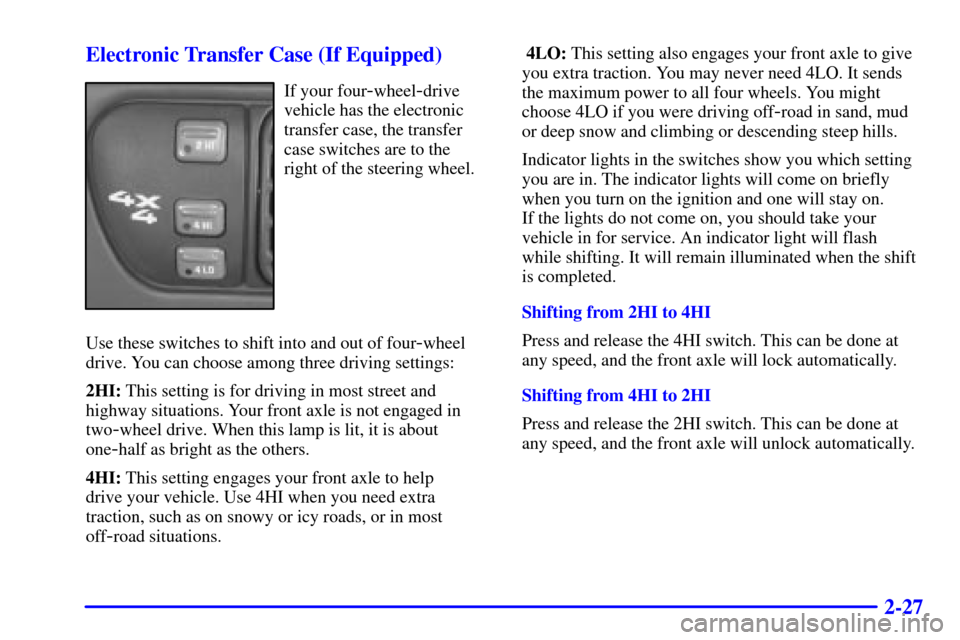
2-27 Electronic Transfer Case (If Equipped)
If your four-wheel-drive
vehicle has the electronic
transfer case, the transfer
case switches are to the
right of the steering wheel.
Use these switches to shift into and out of four
-wheel
drive. You can choose among three driving settings:
2HI: This setting is for driving in most street and
highway situations. Your front axle is not engaged in
two
-wheel drive. When this lamp is lit, it is about
one
-half as bright as the others.
4HI: This setting engages your front axle to help
drive your vehicle. Use 4HI when you need extra
traction, such as on snowy or icy roads, or in most
off
-road situations. 4LO: This setting also engages your front axle to give
you extra traction. You may never need 4LO. It sends
the maximum power to all four wheels. You might
choose 4LO if you were driving off
-road in sand, mud
or deep snow and climbing or descending steep hills.
Indicator lights in the switches show you which setting
you are in. The indicator lights will come on briefly
when you turn on the ignition and one will stay on.
If the lights do not come on, you should take your
vehicle in for service. An indicator light will flash
while shifting. It will remain illuminated when the shift
is completed.
Shifting from 2HI to 4HI
Press and release the 4HI switch. This can be done at
any speed, and the front axle will lock automatically.
Shifting from 4HI to 2HI
Press and release the 2HI switch. This can be done at
any speed, and the front axle will unlock automatically.
Page 97 of 430
2-29 Automatic Transfer Case (If Equipped)
The transfer case switches
are to the right of the
steering wheel on the
instrument panel. Use these
switches to shift into and
out of four
-wheel drive.
You can choose among four
driving settings:
2HI: This setting is used for driving in most street and
highway situations. Your front axle is not engaged in
two
-wheel drive. This setting also provides the best
fuel economy.
AUTO 4WD: This setting is ideal for use when road
conditions are variable. When driving your vehicle in
AUTO 4WD, the front axle is engaged, but the vehicle's
power is sent only to the rear wheels. When the vehicle
senses a loss of traction, the system will automatically
engage four
-wheel drive. Driving in this mode results in
slightly lower fuel economy than 2HI.
Page 141 of 430
2-73
Instrument Panel
A. Air Vents
B. Instrument Cluster
C. Transfer Case (If Equipped)
D. Glove Box
E. Audio System
F. Auxiliary Power OutletsG. Rear Window Defogger
H. Comfort Controls
I. Ashtray
J. Rear Liftgate Release
K. Rear Window Washer/WiperL. Audio Steering Controls
(If Equipped)
M. Brake Release
N. Fog Lamps
O. Lamp Controls
Page 197 of 430
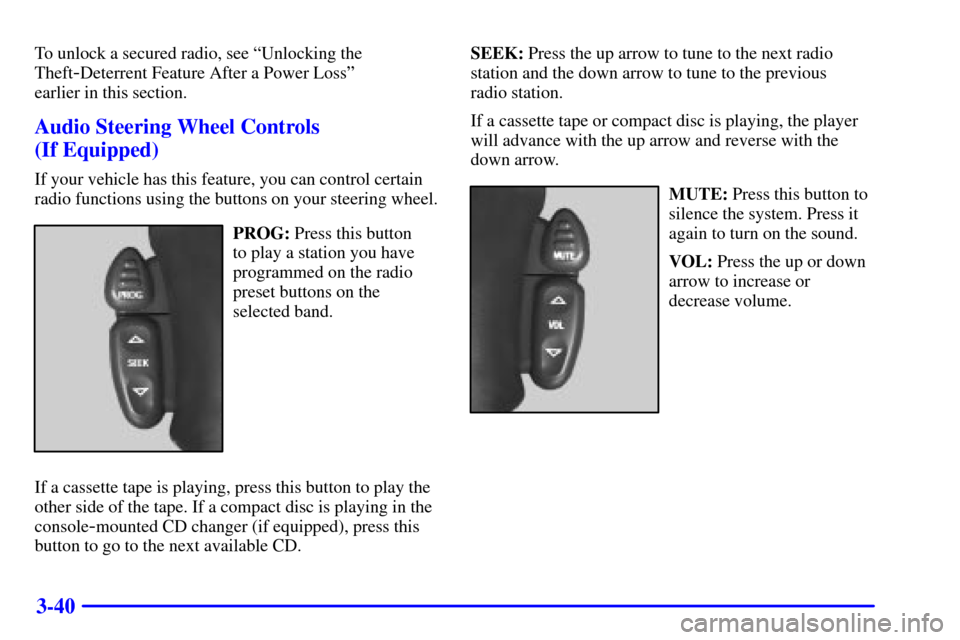
3-40
To unlock a secured radio, see ªUnlocking the
Theft
-Deterrent Feature After a Power Lossº
earlier in this section.
Audio Steering Wheel Controls
(If Equipped)
If your vehicle has this feature, you can control certain
radio functions using the buttons on your steering wheel.
PROG: Press this button
to play a station you have
programmed on the radio
preset buttons on the
selected band.
If a cassette tape is playing, press this button to play the
other side of the tape. If a compact disc is playing in the
console
-mounted CD changer (if equipped), press this
button to go to the next available CD.SEEK: Press the up arrow to tune to the next radio
station and the down arrow to tune to the previous
radio station.
If a cassette tape or compact disc is playing, the player
will advance with the up arrow and reverse with the
down arrow.
MUTE: Press this button to
silence the system. Press it
again to turn on the sound.
VOL: Press the up or down
arrow to increase or
decrease volume.
Page 212 of 430

4-11
Steering
Power Steering
If you lose power steering assist because the engine
stops or the system is not functioning, you can steer but
it will take much more effort.
Steering Tips
Driving on Curves
It's important to take curves at a reasonable speed.
A lot of the ªdriver lost controlº accidents mentioned on
the news happen on curves. Here's why:
Experienced driver or beginner, each of us is subject to
the same laws of physics when driving on curves. The
traction of the tires against the road surface makes it
possible for the vehicle to change its path when you turn
the front wheels. If there's no traction, inertia will keep
the vehicle going in the same direction. If you've ever
tried to steer a vehicle on wet ice, you'll understand this.
The traction you can get in a curve depends on the
condition of your tires and the road surface, the angle at
which the curve is banked, and your speed. While you're
in a curve, speed is the one factor you can control.Suppose you're steering through a sharp curve. Then you
suddenly accelerate. Both control systems
-- steering and
acceleration
-- have to do their work where the tires meet
the road. Adding the sudden acceleration can demand too
much of those places. You can lose control.
What should you do if this ever happens? Ease up on the
accelerator pedal, steer the vehicle the way you want it
to go, and slow down.
Speed limit signs near curves warn that you should
adjust your speed. Of course, the posted speeds are
based on good weather and road conditions. Under less
favorable conditions you'll want to go slower.
If you need to reduce your speed as you approach a
curve, do it before you enter the curve, while your front
wheels are straight ahead.
Try to adjust your speed so you can ªdriveº through the
curve. Maintain a reasonable, steady speed. Wait to
accelerate until you are out of the curve, and then
accelerate gently into the straightaway.
Page 222 of 430
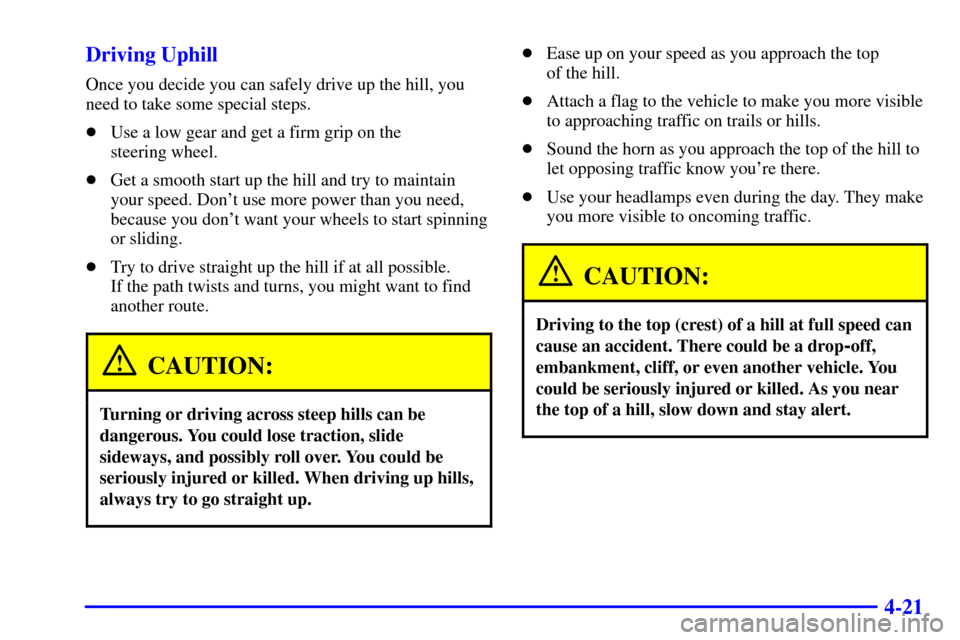
4-21 Driving Uphill
Once you decide you can safely drive up the hill, you
need to take some special steps.
�Use a low gear and get a firm grip on the
steering wheel.
�Get a smooth start up the hill and try to maintain
your speed. Don't use more power than you need,
because you don't want your wheels to start spinning
or sliding.
�Try to drive straight up the hill if at all possible.
If the path twists and turns, you might want to find
another route.
CAUTION:
Turning or driving across steep hills can be
dangerous. You could lose traction, slide
sideways, and possibly roll over. You could be
seriously injured or killed. When driving up hills,
always try to go straight up.
�Ease up on your speed as you approach the top
of the hill.
�Attach a flag to the vehicle to make you more visible
to approaching traffic on trails or hills.
�Sound the horn as you approach the top of the hill to
let opposing traffic know you're there.
�Use your headlamps even during the day. They make
you more visible to oncoming traffic.
CAUTION:
Driving to the top (crest) of a hill at full speed can
cause an accident. There could be a drop
-off,
embankment, cliff, or even another vehicle. You
could be seriously injured or killed. As you near
the top of a hill, slow down and stay alert.